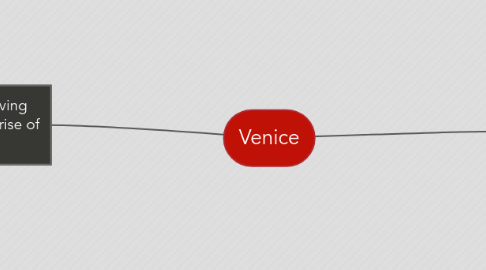
1. Characteristics and driving factors that led to the rise of Venice
1.1. Characteristics of Venice
1.1.1. 1.1 Geography
1.1.1.1. Made up of a lagoon of about 120 small islands which are protected by the longer islands from the currents of Adriatic Sea. Deep channels of water run in between these islets.
1.1.1.2. Several salt marshes on the lagoons became profitable resource for Venetians. Venice's strategic location contributed to the rise of Venice.
1.1.2. 1.2 Early Days
1.1.2.1. Early settlers who were mainly refugees mostly became seamen.
1.1.2.2. Early Venetian use their advantage and traded salt and fish, eventually monopolizing the salt trade in the region. Established trade agreements with different communities.
1.1.2.3. Created urban planning system, collect rainwater in wells to ensure constant water supply and integrated the rice and poor in the society.
1.1.2.4. System of government - Three-tiered government structure; people were allowed to elect their own leader
1.1.3. Challenges faced
1.1.3.1. No strong navy to defeat pirates. So, they pay annual gifts to pirates to get safe passage. Venice also had to maintain diplomatic relations with other countries as more states started to become rivals making trade harder.
1.2. Driving Factors
1.2.1. Leadership
1.2.1.1. Establish control in Adriatic Sea
1.2.1.2. Building the Venetian empire by weakening the Byzantine empire
1.2.1.3. Expanding the Venetian empire in the Mediterranean Sea
1.2.2. Reforms in the government
1.2.2.1. Meeting the growing needs of the city-state by creating the Great Council and through specialization of duties
1.2.2.2. Effective checks on power to prevent corruption and concentration of power
1.2.3. Trade Development & Expansion
1.2.3.1. Venetians' positive and enterprising spirit towards trading
1.2.3.1.1. Skilled diplomats to get favourable trading conditions to get an edge over competitors
1.2.3.1.2. Explored new routes such as Asia and reap more profits
1.2.3.2. Innovations in maritime technology
1.2.3.2.1. Able to overcome bad weather and prevent attacks from pirates
1.2.3.3. Efficiency in managing voyages
1.2.3.3.1. created management system to manage voyages
1.2.3.4. Overcoming trade competition
1.2.3.4.1. Defeated Genoa and monopolized Mediterranean Sea
1.2.4. Industrial Development
1.2.4.1. Building Arsenal to facilitate production
1.2.4.2. Growth of manufacturing industries due to increasing demand for Venetian goods as trading boost
1.2.5. Innovative Practices
1.2.5.1. Double-entry bookkeeping
1.2.5.2. Giro-banking
2. What Venice was like at the peak of development
2.1. Political
2.1.1. Being a maritime empire, Venice possessed territories along important trade routes.
2.1.2. Established dominant commercial power in the region especially after successfully suppressing piracy.
2.2. Social
2.2.1. Became a cosmopolitan city- state as the ease of commercial activities attracted many foreign traders.
2.2.2. After the Black Death plague that killed 60% of population, the government promoted migration into Venice using incentives. Attracted nobles and distinguished professors into Venetian universities.
2.2.3. The outstanding arts achievements made Venice a centre of the arts in Europe. There were also scientific and literary developments as trade and industries grew.
2.3. Economic
2.3.1. High demand for Venetian goods due to high quality, causing increase in trade and income. Craftsmen were talented and well-paid.
2.3.2. Guilds or trade unions were created to ensure job security and maintain quality of goods.

